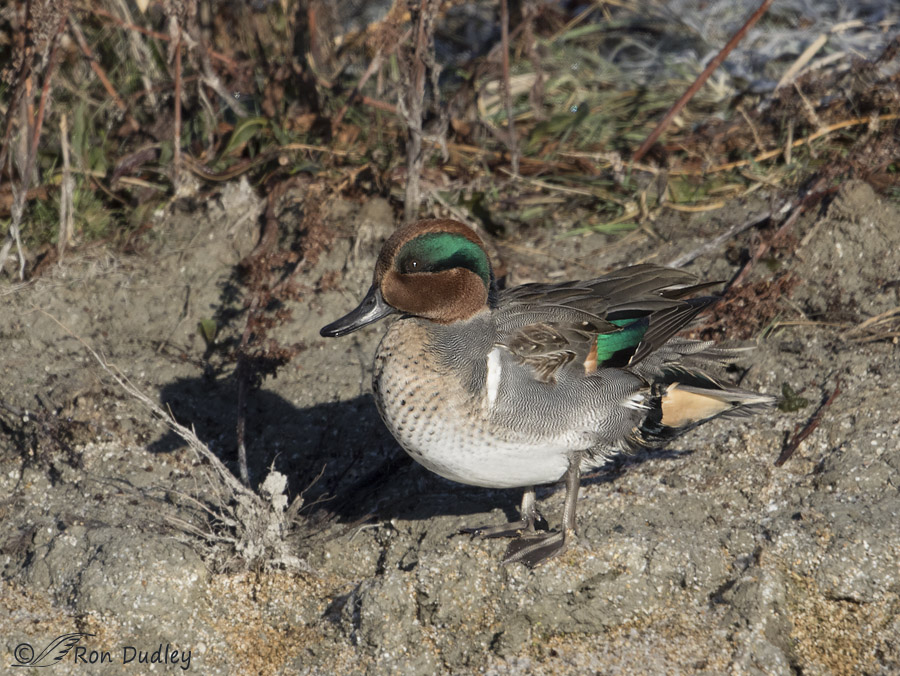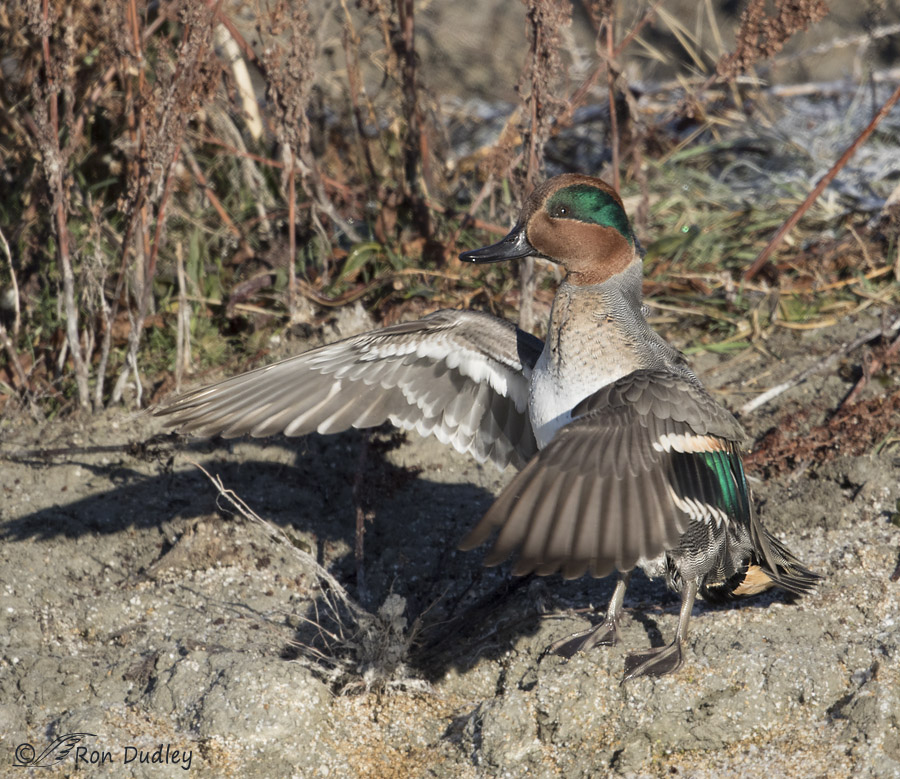The Green-winged Teal is our smallest duck and to my eye the male is strikingly handsome and colorful, especially when you can catch the light just right on the iridescent greens of the crescent above and behind the eye. It’s amazing how that crescent turns black in an instant at differing light angles.

1/3200, f/6.3, ISO 640, Canon 7D Mark 2, Canon EF500mm f/4L IS II USM +1.4 tc, not baited, set up or called in
I photographed this dandy little male two mornings ago at Farmington Bay when it came out of the water to preen. Though the setting is busy and somewhat unattractive I enjoy seeing the entire bird, including the feet, for a change of pace. But my point with these photos is more about bird photography technique than it is about classically beautiful images.
I’ve said before that whenever possible I almost instinctively shoot birds at relatively high shutter speeds in most situations because I gravitate toward action and behavior shots and birds are so very fast and unpredictable. Here my 1/3200 sec shutter speed is fairly typical for me. But I’d photographed this duck for quite a while as it preened on the shore of the pond among a group of foraging coots so I decided to drop my ISO from 640 to 500 for just a couple of shots in order to reduce the grain (noise) in some of my images. Doing so of course dropped my shutter speed by half.

1/1600, f/6.3, ISO 500, Canon 7D Mark 2, Canon EF500mm f/4L IS II USM +1.4 tc, not baited, set up or called in
Naturally the teal chose that precise moment to give me a nice wing flap at an angle with good light on the entire body and my slower shutter speed of 1/1600 sec could not freeze the wings, which disappointed me. If the setting had been more attractive and less busy I’d have been even more disappointed.
Photography is often a bag-full of tradeoffs and juggling shutter speed with ISO is almost a given with birds. Often it’s a matter of style and preferences – how much noise are you willing to tolerate and do you want perfect static shots more or less than you do action images. In this case I could have switched from f/6.3 to f/5.6 for more shutter speed and less depth of field. But I didn’t and you simply can’t go back and do it all over again…
Adobe finally updated ACR (Adobe Camera Raw) to support the Canon 7D Mark 2 and these two images are the first ones I’ve been able to process with the new camera using my usual work flow. What a joy! I’ve been shooting in both RAW and JPEG for over two weeks now so I’ll be extra busy in the next few days as I cull almost 4000 RAW images and delete all those JPEGS at the same time I’m trying to maintain my normal shooting, culling, processing and blogging schedule. Throw in all the preparations for the upcoming holiday and my plate is full to overflowing (as it will almost certainly be Thanksgiving afternoon…)
I apologize for all the photography geekiness in this post but without that geekiness there are no quality images. Back to more typical fare tomorrow.
Ron


the textures in your photos are amazing most photos i take are so flat but your seem to be almost 3d great images he is a handsome duck.
Hi Ron!
I love “habitat” in your shots…helps transport me to the feelings of being with the subject of the photo.
So, I played around with shot #1 and “cropped” it about 1/5or less down from the top. Still has emotional hit of being in the wild, and that beautiful duck is more the focus.
Thank you for sharing your amazing work/love with us!
SUE
Aah, the light! I didn’t know how much I appreciated it until I moved to the Northwest, where in the winter, even on sunny days, the light can be so low and diffused ] that using a shutter speed of even 1/1250 requires a high ISO. The equation you discuss here is one I’m always weighing — I like to be at the ready for movement — but in low light, it’s a trade off of ISO/image quality and shutter speed. We’re all fortunate that today’s technology allows for pushing that ISO, even on my little M43 system. Still … the light. It’s all about that.
Love the colour and the motion doesn’t bother me-it is expressive.
I rely on geeks in so many aspects of my life. And am more than happy to see anyone’s inner geek peeking out from behind the parapets. Geeks are passionate about their field – and passion trumps indifference and ignorance every day. Or should.
And I loved the teal as well.
Go Geek, Go!
It’s becoming a geeks world in some ways, Elephant’s Child, so it’s a good thing we often appreciate them. Loved your cheer!
Fantastic shots Ron!
Charlotte
Thanks, Charlotte.
Hi!
What a beautiful bird! You caught the colors and everything is so bright and Great work! Keep it up! Have a great day1
Thank you, Hummingbird Lover. Hope you’re keeping warm out your way!
I like the wing blur in the second photo; it conveys better what the bird is doing
If you ever want to let you’re geek run wild and write a post on your 7D2 settings and how these differ from 7D, as well as any differences in processing you find, you’ll have an avid reader here!
“let your geek run wild”. I liked that, Mark!
I’ll likely do just that sometime down the road but it’s going to take me a while to get my preferences fine-tuned. Birds are pretty slow around here right now so I haven’t had much opportunity to experiment with the Mark 2, especially with birds in flight. And now that I can FINALLY use ACR I should be able to notice processing differences between the two cameras during the work flow that I’m most used to. Thanks for the suggestion!
I love the ‘smile’ on the teal… and that due to your persistence and skill, your ‘hits’ in the constantly shifting equation of speed versus grain are so delightful.
Thanks, Alison. I sure have a lot of misses for every hit though…
Great shots of a most beautiful bird, Ron. Your photography is definitely some of the best out there and I really appreciate the “photography geekiness”. It helps me understand photography so much better and in turn is helping me to become a better photographer myself. Once again thank you very much. (and please keep up the “geekiness”)
Thank you, Steve – that means a lot. I know that there’s a fair number of bird photographers that follow my blog so I do focus on the process rather than the results of photography at times, hoping that some will find it useful when I do.
WOW – I’m impressed! These are two beautiful shots Ron. I’ve saved this shot of yours as a possible carving someday!!
Sorry for the nerdy question, but are you saying if you shot at 1/2400 or 1/3200 rather then 1/1600 and with the light that you had on the duck that you would have lost DOF? I do understand the problem between ISO and speed, but you had very good light.
The first shot looks to me as though you took it just as he was ruffling his feathers to stretch his wings?
You certainly captured the iridescent greens on this male – absolutely beautiful!!
Dick, what I’m saying is that switching from f/6.3 to f/5.6 would have given me less DOF but as a side effect it also increases my shutter speed in the same light (I shoot in aperture priority).
If you look at my file numbers (pass your cursor over the image) you’ll notice that the first shot was taken after the second one. The bird had been preening for a long time and I figured he’d probably do a wing flap at some point but I just chose the wrong moment to change my ISO.
isn’t he a beauty!!! And I for one appreciate what you call your ‘photography geekiness’!!!
Lois, sometimes when I’m composing a post its focus changes as I’m writing. That happened this morning and I just went with the flow so the geekiness blossomed. Thanks for appreciating the way I went with it.
Beautiful Ron!
Thanks, Jean.